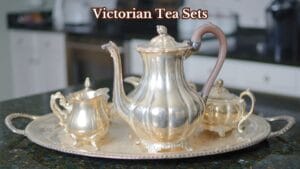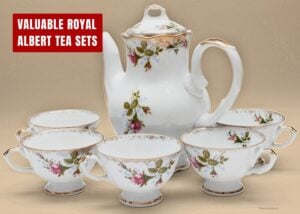Would you believe me if I told you that an antique Victorian tea set recently sold for almost $10,000? Surprising, isn’t it? But old tea sets featuring the extravagant decoration typical of the Victorian era are one of today’s hottest collectibles!
So, in this guide, I’m going to introduce you to some of the rarest antique Victorian tea sets that are selling for insane prices. You’ll also get some expert tips to identify real VICTORIAN styles and what makes these tea & coffee sets worth the money!
1. Antique Tiffany & Co. Silver Plate Tea Set

This gorgeous Tiffany & Co. Victorian silver plate tea service is a real showstopper. It’s a complete seven-piece set that includes everything you need: coffee pot, teapot, sugar bowl, creamer, and waste bowl! Plus, the stunning ornate tray with intricate repoussé handles is the real bonus!
What I love about this set is its hand-chased decorative work, from the elaborate finials to those elegant curved spouts and handles. You can see the quality in every inch of metalwork, plus brand and metal marks, typical of Tiffany’s pieces. The stunning price is apt for Tiffany’s authenticity plus completeness, and preservation!
2. French Christofle Silverplate Guilloche Tea & Coffee Set
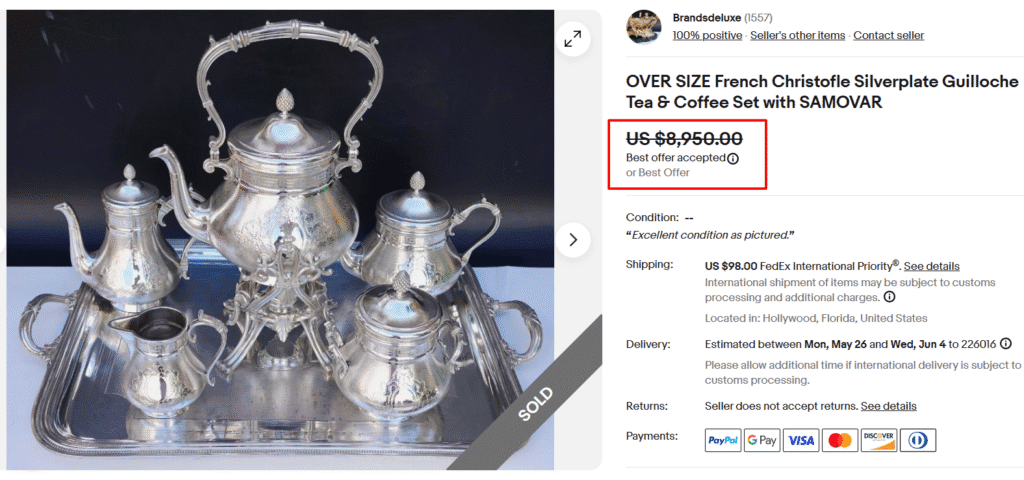
This magnificent French Christofle samovar set is one of the rarest finds, as reflected by its stunning price tag of $8,950! With its silver-plated composition, this set represents a beautiful blend of French luxury craftsmanship and traditionally Russian form.
The samovar form itself has deep cultural significance; it’s a container used to boil water and keep it hot, with a smaller teapot that fits neatly on top. What makes the set collectible is the elegant Victorian design elements with fine details on silverplate.
3. Wehsener Dresden Watteau Scenes Gold Tea Set
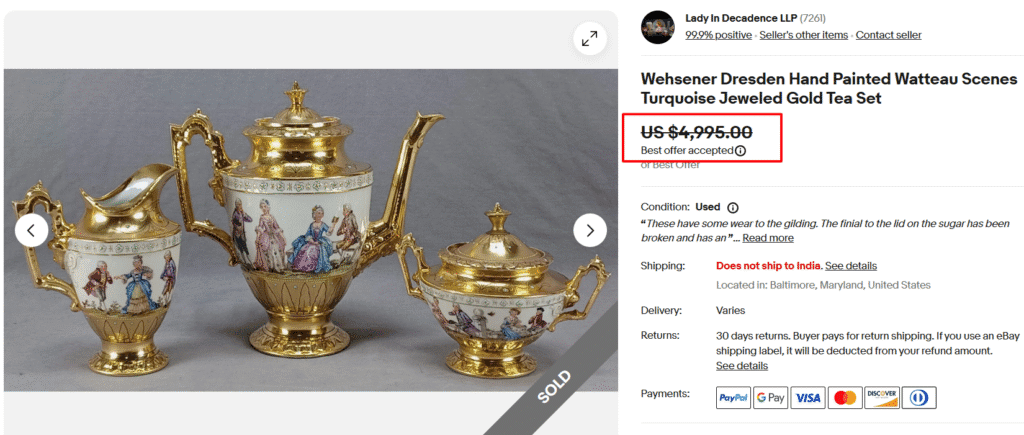
This rare Dresden tea set showcases the incredible artistry of German porcelain decorators. Founded in 1895, the Wehsener company became known worldwide for “Dresdner Handpainting” and “Dresden China.”
The hand-painted Watteau scenes on this set are particularly noteworthy. Dresden decorators often worked with pastoral scenes inspired by the French artist Antoine Watteau, interspersed with panels of flowers. The turquoise and jeweled accents further make this set more exquisite, reflecting 19th-century arts.
Well-preserved Dresden pieces, like this tea set, can sell for $1,500-$5,000, with rare pieces even making their way to the British Museum and the National Museum in Washington, DC.
4. Antique Stieff Repousse Sterling Silver Tea/Coffee Set

The sterling silver tea set is a collector’s Holy Grail! It’s from the Stieff Company, which was known for the quality and value of its silver products, beautiful hand chasing, and Repoussé work (involves creating designs by hammering the silver from the reverse side).
What’s particularly impressive about this five-piece set is its stunning repoussé work and substantial weight. The ornate styling reflects the Victorian and Edwardian love of decoration and shows why Stieff pieces remain highly collectible today. Full sets can fetch thousands of dollars.
5. Herend, Queen Victoria Porcelain Tea Set
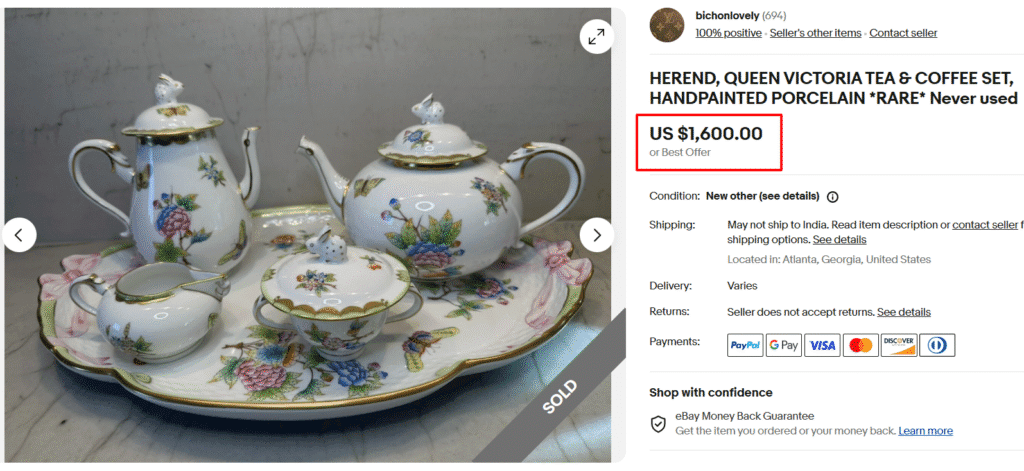
Sold at $1,600, this set is nothing short of spectacular—a Herend Queen Victoria tea and coffee set. Herend’s Queen Victoria pattern was introduced at the Great Exhibition in London in 1851, where it won a gold medal. Queen Victoria herself fell in love with the design and ordered a complete set for Windsor Castle!
The design features stylized butterflies and sprigs of blossom painted in cheerful and lively colors. The strong element of peonies derives from China, and the combination of red, blue, purple, yellow, and green butterflies, flowers, and sprigs makes a cavalcade of color.
Such exquisite pieces, if found in mint condition, just as this example, can fetch $800-$2,000 or more!
6. Antique Graniteware Enamelware Herons Tea Set
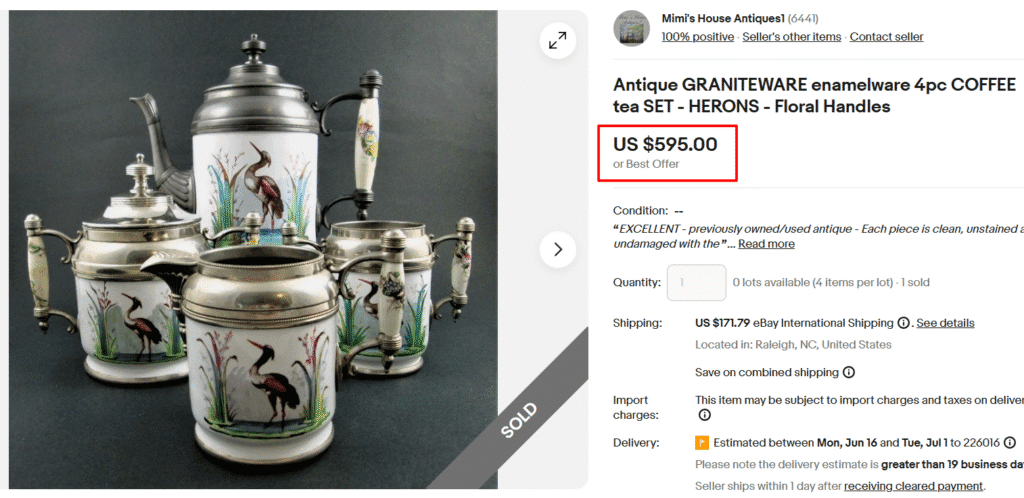
This is one of the most unique vintage Victorian tea sets! Graniteware describes enameled metal dishes (coffee pots, colanders, pans, etc.) produced throughout the Midwestern and Eastern United States from the 1870s until the end of World War II.
This set features the heron motifs, which represent American folk art at its finest. These pieces were designed for everyday use – they were durable, easy to clean, and affordable. The floral handles and nature scenes show that even practical items could be beautiful.
Patented in 1848 by New York inventor Charles Stumer, graniteware was also known as agateware, enameled ware, and speckleware. Finding this set in excellent condition is rare!
7. Wedgwood Jasperware Crimson Tea Set

Crimson Red Wedgwood Jasperware is quite a rare find, making this set worth the price. The design features the classical white relief figures against the deep crimson background, creating a stunning visual contrast.
Initially introduced in the late 19th century, the short production of red Jasperware was suspended somewhere between 1891 and the early 1900s due to its difficulty in craft (color bleeding was the main culprit). A very small batch was produced in 1910, and in a final attempt to perfect this color, the company reissued it in the mid-1920s to the early 1930s.
Today, Crimon Jasperware can fetch $500-$2,000 due to its rarity, with the values depending on condition and completeness.
8. Shelley Bone China Dainty Blue Tea Set

The charming Shelley Dainty Blue set is admired for its beloved shapes featuring scalloped edges. The popular Dainty shape was created by artist Rowland Morris and was popular from its introduction in 1896 right up to the close of the works in 1966.
The pattern features a white background decorated with sprays of blue flowers, with the Shelley trademark “petal” pattern set into the body of each plate. What makes Shelley so special is the incredible thinness of their bone china – it’s almost translucent yet remarkably strong.
9. Royal Crown Derbi Imari Tea Set

This Royal Crown Derby set features England’s most beloved patterns, the Old Imari. Inspired by traditional Japanese Imari porcelain, which was highly prized in Europe during the 17th and 18th centuries, the Old Imari pattern reflects an oriental art form, like the diamond lozenges.
The design features a rich color palette of cobalt blue, iron red, and lavish gold accents with compartmental design. Introduced in the early 20th century, Old Imari quickly became a favorite among those who appreciated fine bone china!
10. Meissen Porcelain Cobalt Blue Flora Tea Set

This huge Meissen tea set is nothing short of porcelain perfection. Meissen began producing its “white gold” hard-paste wares in 1710, and by the following decade, the Meissen trademark was a renowned symbol of exceptional production.
The deep cobalt blue ground with floral bouquet medallions represents classic Meissen artistry. The Flora Bouquet pattern showcases Meissen’s mastery of combining rich cobalt blue backgrounds with delicate hand-painted florals and intricate gold detailing.
This set, in pristine condition, justifies its exceptional realized price of $3,850. Some sets can even fetch up to $5,000!
11. Coalport Indian Tree Tea Set
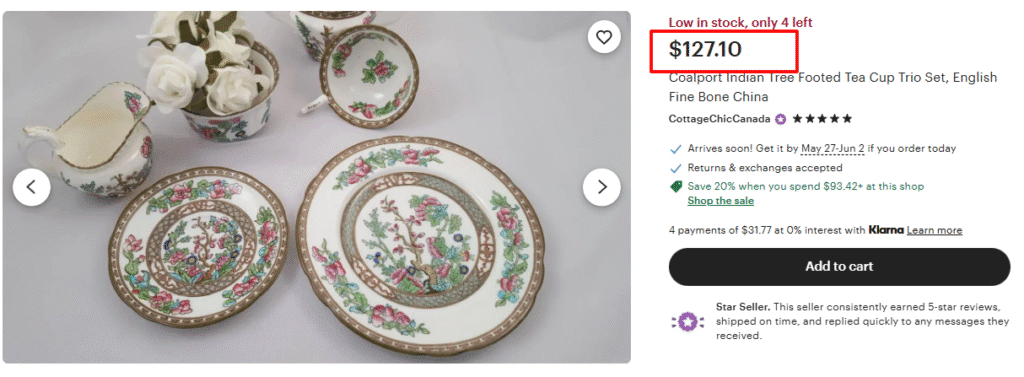
Coalport’s Indian Tree is one of the most beloved patterns in English china. Coalport debuted this pattern in 1802 in their Shropshire, England factory, and it was immensely popular, with a large section of the factory devoted to its production.
The Indian Tree pattern is set apart by its botanical representation of a tree with blooming pink, red, blue, green, orange, or yellow blossoms against a white, bone, or cream background. This particular set’s scalloped edges and gold trim show the classic Coalport styling!
How to Identify a Real Victorian Tea Set? (Key Signs to Spot)

Now picture this: You spot an elegant tea set in an estate sale or maybe in your mother’s cabinets. But how would you know if it’s a genuine Victorian treasure worth hundreds—or just a pretty reproduction worth twenty bucks?
Let’s start simple. The Victorian era ran from 1837 to 1901, during Queen Victoria’s reign. But just because something is old doesn’t make it Victorian.
Here’s how to identify real Victorian pieces:
Materials
The Victorian-era vintage tea sets were typically made of the following materials:
- Bone China: It’s made with bone ash, which makes it strong but still delicate. It’s translucent with a warm, creamy white color. It makes a clear ring when tapped and feels surprisingly light for its strength.
- Fine Porcelain: Good porcelain is almost as desirable as bone china. It’s pure white and thin, almost glassy looking. It’s typically cold to the touch initially.
- Earthenware and Stoneware: These were the middle-class options. They’re heavier and thicker, often beautifully decorated despite being “everyday” sets.
- Silver: Solid silver tea sets were luxury items. Sterling silver will typically be marked with hallmarks. It’s significantly heavy and shows natural aging (patina).
Design & Pattern Clues
The Victorians had distinctive tastes, more extravagant. Once you know what to look for, their patterns are unmistakable.
- Floral Designs: Flowers, especially roses, were everywhere in Victorian tea sets. But they loved all the flowers. Generally, the patterns are realistic roses in full bloom, violets and pansies, and garden scenes. Hand-painted flowers are more valuable, while transfer-printed flowers are more common!
- Chinoiserie (Oriental Style): Victorian pieces feature Asian-inspired patterns, such as blue and white color schemes, pagodas and oriental figures, dragons and mythical creatures, and willow pattern variations.
- Gothic Revival: These styles reflect Victorian architecture trends. For instance, Medieval-style motifs, heraldic designs, and rich and dark colors are typical. Also, these are more dramatic than floral patterns.
Renowned Makers & Marks
Knowing the maker can instantly tell you if you’ve found a real Victorian set. Here are the heavy hitters:
- Wedgwood: Still famous today, they made everything from everyday sets to museum pieces. Look for their name stamped on the bottom.
- Spode: Masters of transfer printing. Their Blue Italian pattern from 1816 is still in production today—that’s staying power.
- Royal Worcester: Started in 1751, they used a complex dating system with letters and symbols. High-quality stuff.
- Royal Albert: Known for bone china and the famous Old Country Roses pattern. Still highly collectible.
- Minton: Innovative with glazes and known for artistic standards. Their pieces often feel like small artworks.
- Meissen (Germany): The holy grail of porcelain. Look for their crossed swords mark. Even 19th-century pieces can be worth hundreds or thousands.
- Sèvres (France): Royal French porcelain with elaborate decorations. Museum-quality pieces.
- Limoges (France): Pieces made at different factories in Limoges. Known for delicate hand-painted decorations.
Now, not all antique Victorian tea sets will be marked. But some certainly are.
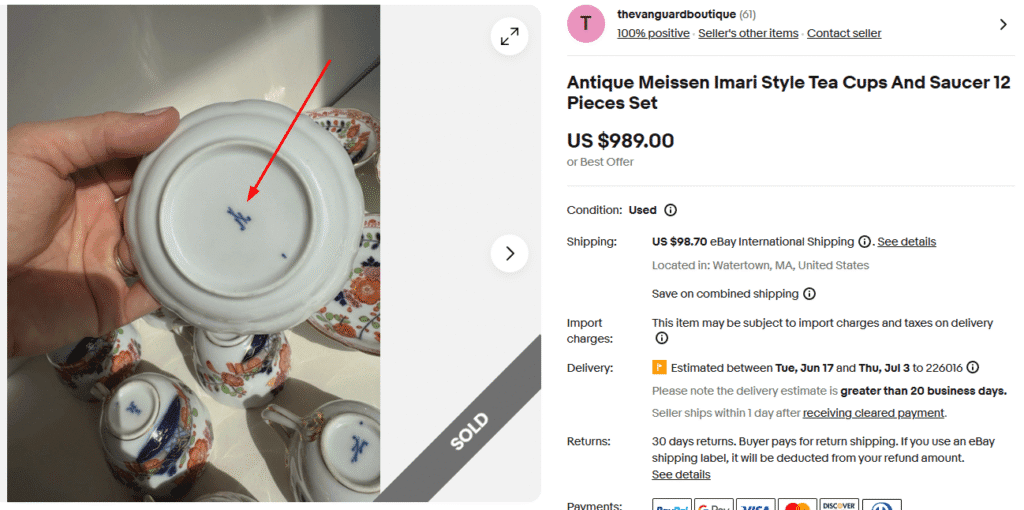
So, What to Look For?
- Company Names: Always look for the manufacturer’s name. It might be stamped, painted, or impressed.
- Symbols: If not names, some pieces may bear distinctive markings (for example, Meissen’s swords).
- “England” vs “Made in England”: If it says “Made in England,” it’s after 1921 (not Victorian). Just “England” could be Victorian.
- Pattern Names or Numbers: Started around 1810. Pattern names help identify and value pieces.
- Registration Marks: Diamond-shaped marks (1842-1883) can give exact dates. After 1884, they used sequential numbers.
- Hallmarks (Silver): Silver tea sets have their own marking system. You may see Town Mark that shows where it was tested (London = leopard’s head), Purity Mark: Lion symbol means sterling silver (92.5% pure), Date Letter, and Maker’s Mark.
What Makes an Antique Victorian Tea Set Valuable?
- Condition: Condition is the key! Even a small chip can cut the value of a tea set in half. Always look for cracks (even tiny hairline cracks), chips on rims and handles, staining, crazing (fine cracks in the glaze), and repairs. Any of these signs means low value.
- Completeness: Individual cups and saucers sell for $20-200. But complete sets? That’s where serious money lives. Ideal sets include cups & saucers, a teapot with its original lid, a sugar bowl (preferably with a lid), and a cream jug. Bonus points for extras like trays and cake plates!
- Rarity: A tea set with a pattern that was made for a limited time or in a limited number? Big bucks! But naturally, some patterns are more desirable than others due to their beauty, historical significance, or association with a particular maker.
- Craftsmanship: Hand-painted designs are the cream of the crop! Similarly, other techniques like elaborate gilding (those gold or silver accents), 19th-century transfer prints, and enamel work can add serious value!
Note: This article is intended for informational, educational, and entertainment purposes only. Some images are illustrative and may not represent actual brands, products, or related entities. All trademarks, product names, brand logos, packaging, and other intellectual property referenced remain the exclusive property of their respective owners. Any brand mentions or references are provided solely for descriptive and educational context and do not imply any formal or commercial association.

